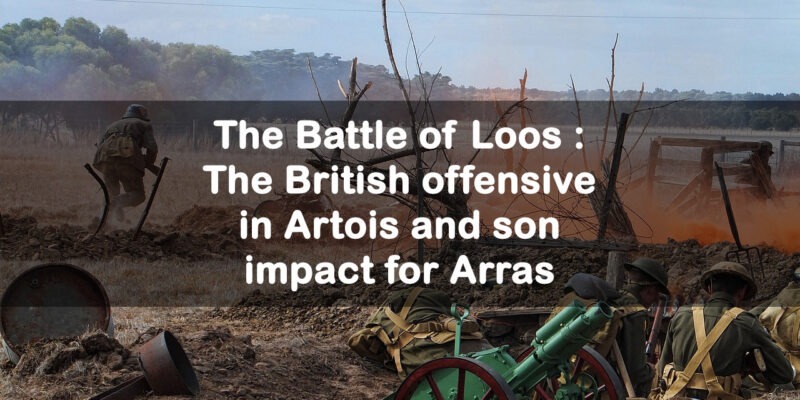On September 25, 1915, the Battle of Loos broke out in the heart of the Artois region, marking a milestone on the Western Front of the First World War. In 1915, the front lines stagnated, with each army holed up in its own trenches. Arras, not far from this zone of intense fighting, was at the heart of strategic concerns. It was here that the British general staff, in coordination with the French army, hoped to break through the German lines in Artois and push the enemy back towards Belgium. However, despite ambitious plans for attack, the Allies soon found themselves confronted by the unforgiving conditions and obstacles of the battlefield. Let’s take a look back at the stakes involved in the Battle of Loos and its failure, which also left its mark on the history of Arras and the surrounding area.
Allied ambition: Break through enemy lines in Artois
Since the start of the First World War, the Arras and Artois region has regularly been the scene of major battles. The French and British general staffs, seeing the trenches immobilizing the front, decided to coordinate a major offensive in September 1915. . Cette « Grande Attaque » was to take place on two fronts: the French army attacked in Champagne, while British troops, supported by French contingents, led an offensive in Artois. Arras became a strategic assembly point, where the Allies hoped to create a breach to disrupt the German lines and enable a significant advance northwards. To ensure the success of the attack, the British began an intense bombardment of the German lines on September 20, attempting to destroy the barbed wire and destabilize the enemy positions.
This strategy, designed to prepare the ground for a rapid advance, proved to be ineffective, as the German fortifications remained largely intact. On this occasion, the Allies deployed chlorine gas for the first time, hoping to use it as a decisive weapon to weaken German defenses. Unfortunately, the headwind blew the gas back towards the British soldiers, trapping many Allied soldiers and revealing the unpredictability of the new chemical weapons on the battlefield. Arras, as a town in the immediate vicinity of the fighting, also suffered the direct repercussions of this offensive: local resources were requisitioned, and civilians, subjected to troop movements, saw their daily lives transformed by the war effort. Despite intensive preparations and the use of chemical weapons, the Loos area and Artois remained insurmountable obstacles for the Allies, exposing their strategic and logistical weaknesses.
Punctual progress but a tragic human toll
On September 25, the assault was finally launched. Seven British divisions, supported by the New Kitchener Army made up of new recruits, threw themselves into the battle. The soldiers had to advance along a 12-kilometer front in the heart of the Artois region, through muddy terrain soaked by heavy rain. In the south, despite unfavorable conditions, the attack achieved notable successes: the British captured the village of Loos as well as the famous “Hill 70”, a strategic point offering an unobstructed view of the surrounding region, including towards Arras. However, this promising advance was quickly brought to a halt by poor logistics: ammunition was in short supply, and reinforcements were slow to arrive. This situation enabled the Germans to counter-attack effectively, retaking “Hill 70” and bringing the British advance to a halt. Further north, British troops faced the formidable “Hohenzollern Redoubt”, a complex of heavily fortified German trenches and dugouts.
The British, exposed to German machine guns, suffered massive casualties: some 8,500 British soldiers were killed in a single day, marking one of the deadliest days for the UK since the start of the conflict. The following day, September 26, German reinforcements arrived in large numbers to defend their positions. Lacking sufficient support, the British launched attacks without any supporting bombardment, a decision that led to terrible loss of life. Unable to hold their positions, they gradually withdrew, abandoning some of the advances made the day before. Despite several days of fierce fighting, the battle of Loos ended without having achieved its objectives, leaving the Artois and Arras region in a fragile situation, at the heart of a front now consolidated by the Germans. Loos-en-Gohelle, site of the battle near Lens :
Next : The impact of the Battle of Loos on the Arras area
Thefailure of the Battle of Loos had major repercussions for the Allies and for the Arras region, which continued to be exposed to fighting and bombardment throughout the conflict. This offensive, with its disastrous human cost, illustrates the difficulties faced by the armies of the day in breaking through the trench lines. In Artois, the failure of this operation left a lasting impression on the population and on Allied military strategy.
Arras, like other towns on the Western Front, saw its infrastructure mobilized, its inhabitants displaced, and its resources drained to support a conflict that dragged on and on. The Battle of Loos remains etched in history as an example of the sacrifices and mistakes of the First World War. Arras and the surrounding area are remembered for this period of suffering, marked by the impact of repeated offensives and often inadequate strategies for breaking through the front line. The battlefield, just a few kilometers from the city, is still a reminder of the fierce fighting that shaped the Artois region and the history of the First World War.
D.A.
